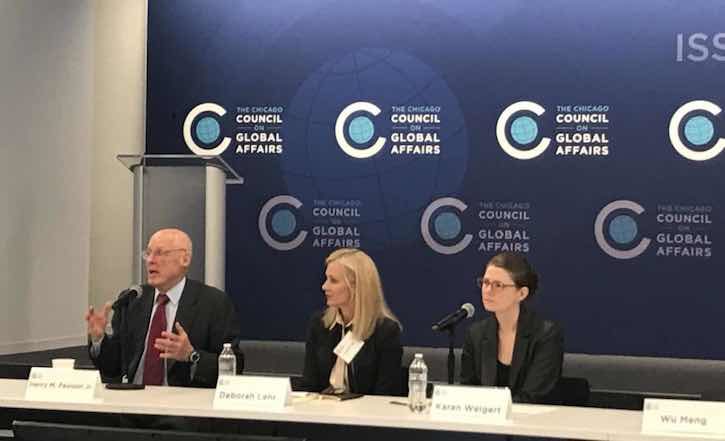
Over the next five years, the Chinese government has declared the fight against pollution as one of its top three priorities—along with risk management and poverty alleviation. Indeed, over the past four years, China has initiated this fight by becoming one of the world’s leaders in green finance and one of the forefront innovators in leveraging private and public sector funds to encourage the transition to a low carbon economy. China has a long way to go as it is still the world’s largest emitter of carbon, but it is taking this intention to promote energy efficiencies and reduce greenhouse gas emissions seriously.

The Paulson Institute and the Chicago Council on Global Affairs convened a roundtable in April to delve into the role of green finance in China, and how the private sector and the government support the green economy. The Institute’s Chairman Henry Paulson and Vice Chairman Deborah Lehr, along with Chicago’s first Chief Sustainability Officer and Chicago Council on Global Affairs senior fellow Karen Wiegert led this timely conversation.
Key takeaways:
- Finding sources of private sector financing are essential if China is to be successful in this fight. China estimates that it needs approximately $800 million annually for the next five years in financing to meet its commitments but the government can only provide approximately 15% of this capital. As such, developing innovative sources of green finance is critical now.
- China has become one of the global leaders in advancing green finance. One highly anticipated achievement was the announcement of a national carbon market, and while a welcomed step, it only covers one industry – power. And the regulatory as well as financial infrastructure remains to be defined for the exchange. We expect to see this built out and extended to other industries over the next five years.
- The results in this battle against pollution to date have been impressive, but there is still a long way to go. On the positive side, China has managed to reduce PM 2.5 in some of the most polluted cities: Beijing – 35%; Baoding 38%, Shijiazhuang 39%. But much work continues to be necessary to reduce these levels consistently and long term.Important to increasing and mainstreaming interest of the private finance sector is a pipeline of viable, bankable, and profitable projects–particularly along China’s Belt and Road Initiative (BRI). The BRI will need $21 trillion in infrastructure development as it touches 65 countries and about 44% of the world’s population. The reach of this initiative will place China in a position to become a major exporter for green finance standards from the project-level to more broadly in lending and carbon markets. In the medium to long term, opportunities for U.S. companies along the BRI will continue to grow as it matures.
- Enforcement is a key part of the battle. The central government has created inspection teams to investigate environmental violations in 30 provinces and regions around the country. Figures from 2017 show about 30,000 companies and 5700 officials penalized in the campaign, which are expected to happen biennially now.
- More immediate opportunities for U.S. businesses leverage China’s fight against pollution. In the direct export of environmental goods and services to China, U.S. firms are well positioned to dominate the market, which is estimated to be about $1 trillion in size. Cutting-edge U.S. green technologies and expertise are still widely sought after.
- Globally, there is an increasing use of green finance to encourage sustainability—especially in China. Underlying this trend, it is important to set standards in terms of transparency, competition, and monitoring to create a strong framework internationally and nationally. While cities like Chicago have active policies to facilitate, implement and regulate, it is not enough. Indeed, comprehensive policies are needed to scale up and provide oversight.



